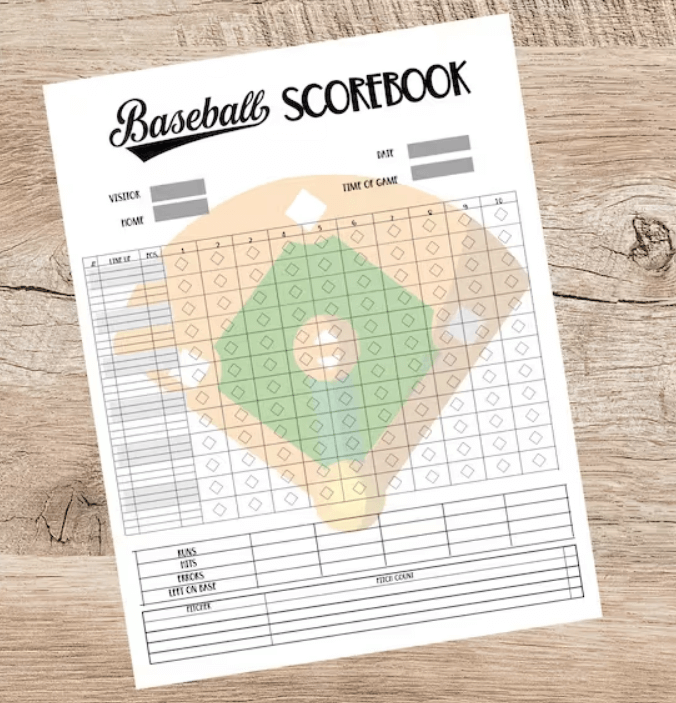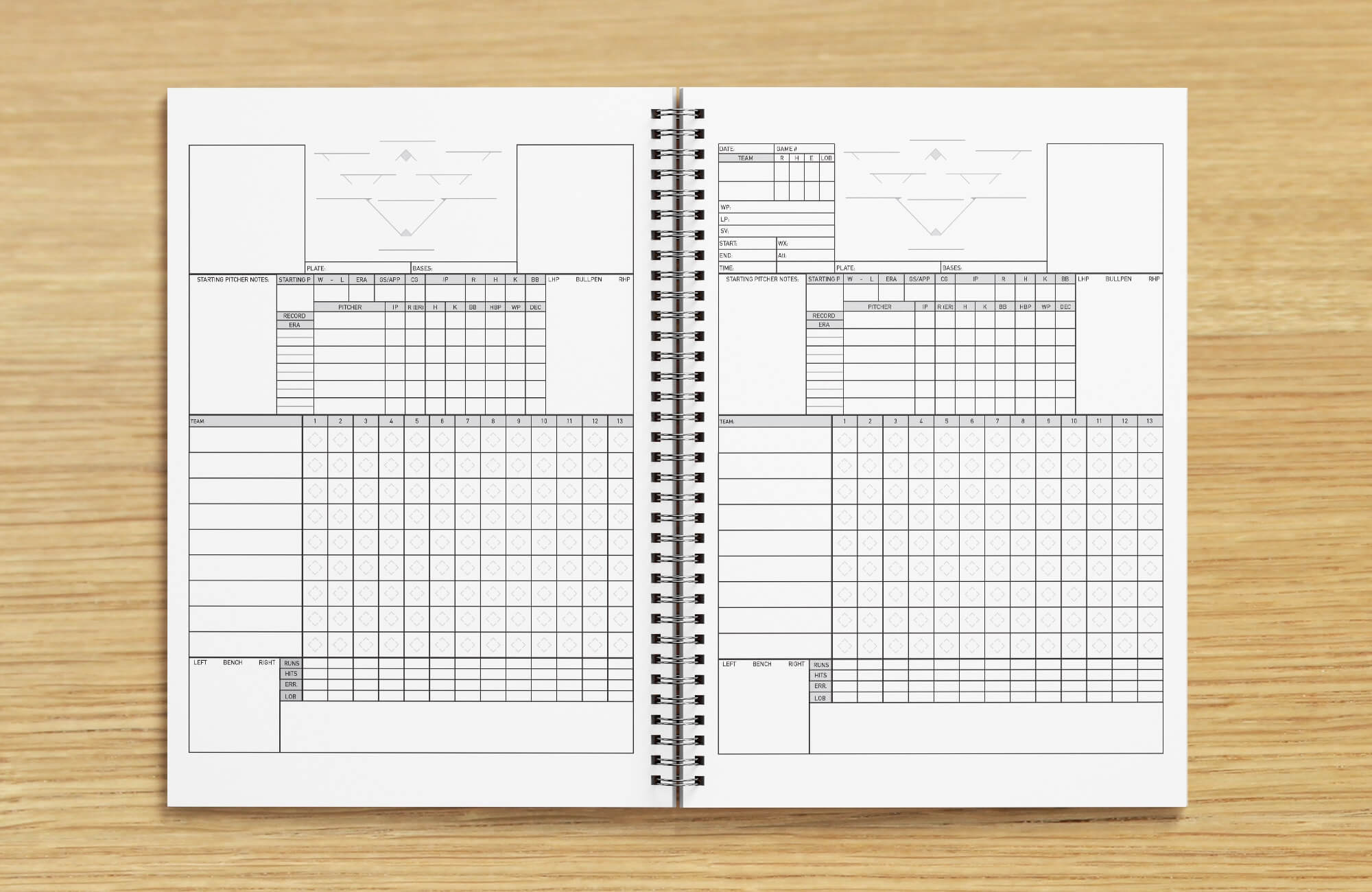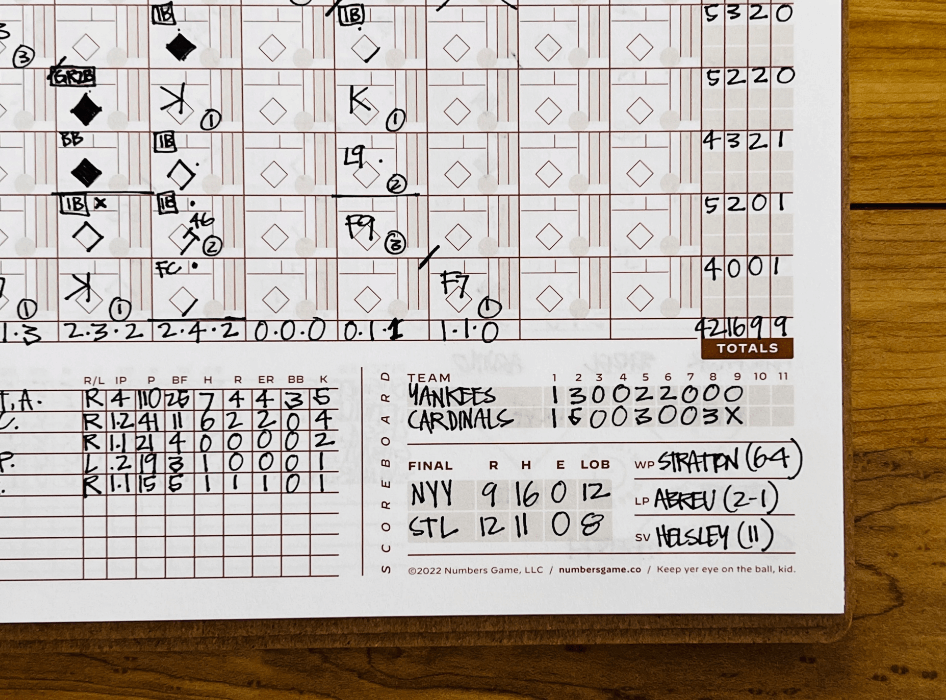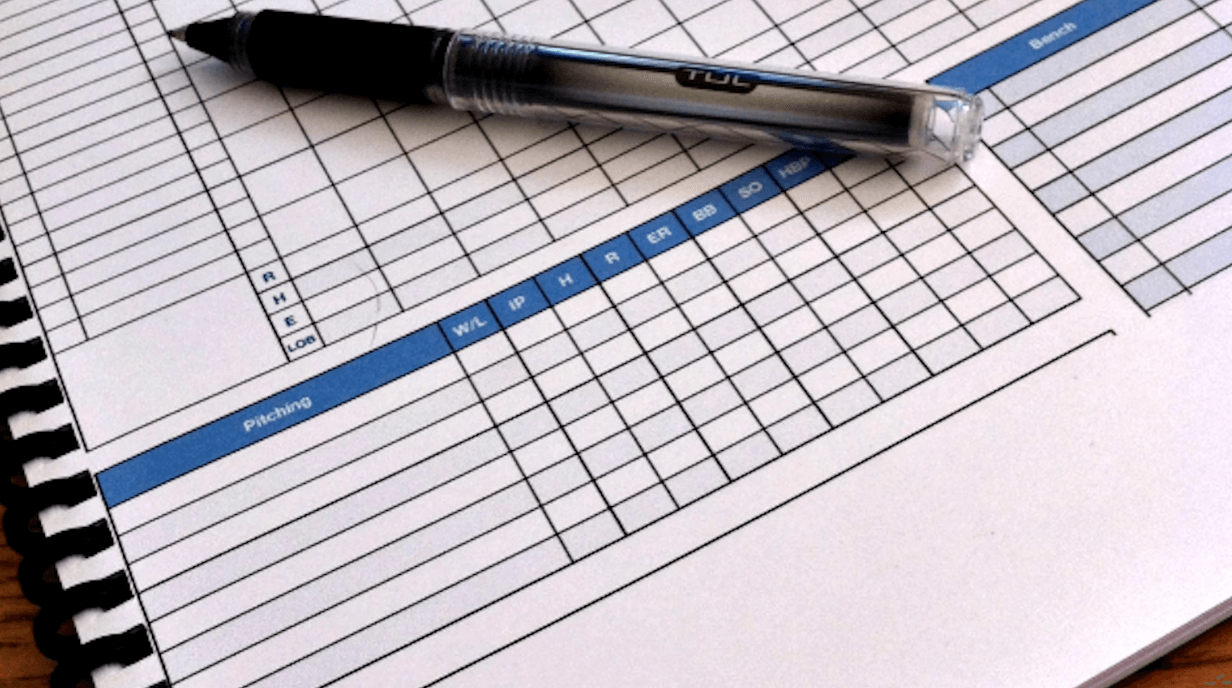A baseball scorebook is used to record the details of a baseball game as it unfolds. Scorekeeping allows fans to track the game’s events, players’ stats, and the evolving situation on the field. By keeping their own scorebook, fans get a unique souvenir that captures the story of the game they attended.
The origins of organized baseball scorekeeping date back to 1845, when Henry Chadwick developed a box score and system to quantify players’ contributions. As baseball grew in popularity in the late 1800s, fans began keeping their own scorecards as a way to better understand the nuances of the game. The practice of filling out scorecards became a standard part of the baseball experience for generations of fans. Keeping score enhanced fans’ connections to the game and provided data that fueled debates and discussions.
As baseball reporter Paul Dickson wrote, “Scoring the game has influenced and enhanced the history of baseball more than any other fan activity.” History of keeping score in baseball – Wikipedia
Materials Needed

To keep score of a baseball game, you’ll need just a few simple supplies:
-
Scorebook – You’ll need a dedicated baseball scorebook to record all the game action. Scorebooks come in different sizes and formats, so choose one that fits your needs. Hardbound books that lay flat work best.
-
Pencil and eraser – You’ll be erasing a lot, so use a soft pencil with a good eraser. Mechanical pencils work fine, but you’ll go through a lot of lead. Many scorers prefer old-fashioned #2 pencils.
-
List of team rosters – Get a roster list from each team with players’ names, numbers and positions. This helps you identify who’s who on the field.
-
Program with player numbers – If available, a game program with team rosters and numbers is handy for cross-referencing.
With just these few items, you’ll be set to score that baseball game! Let’s move on to setting up the scorebook.
Setting Up the Scorebook
Before the game starts, you’ll want to set up your scorebook with some key details.
-
Draw a miniature diagram of the baseball field in the upper corner of the first page. This will allow you to notate where balls are hit during play. Be sure to mark the bases and note that home plate is at the bottom.
-
Write out the starting batting order for both teams on the first page. The away team’s lineup typically goes on the left page and the home team on the right page. List the players’ names, numbers, and positions. Leave some blank rows for substitutions later on.
-
Note the details of the game at the top of the page – date, start time, location, and teams playing. You may want to circle or highlight the home team.
-
Leave a section on the lineup page for writing in substitute players. When a sub enters the game, write their name, number, and position in this area so you can track changes.
Tracking Game Basics
To track the basics of the game in your scorebook, you’ll need to record outs, runs, hits and errors, as well as mark baserunner advances.
When a batter makes an out, draw a circle around their position number in the batting order. For example, if the leadoff batter grounds out to the shortstop, circle the “1” slot in the batting order to indicate the out. When a batter gets a hit, make a mark on the diamond shape on their line in the batting order. If it’s a single, mark the lower right corner. For a double, mark the upper right, and for a triple mark the upper left. Home runs get marked in the lower left corner.
For runs scored, draw a line from home plate toward the player’s name and write the number of runs. So if the #3 hitter doubles to drive in two runs, draw a line from home plate through the diamond on their line and write “2”.
Errors are marked with “E” and the fielder’s number who made the error. So if the shortstop makes an error, write “E6.” Passed balls and wild pitches also get marked with “PB” and “WP”.
To track baserunner advances, draw a line indicating their path. For example, if a runner goes from first to third on a single, draw a line from first base to third base. If they score, draw the line all the way home and add a run. Take note of pickoff attempts and caught stealings as well.
With practice, you’ll get used to efficiently marking all the main plays of the game in your scorebook. Keep the key details clear and consistent.
Notating Common Plays

When keeping score, there are some standard abbreviations and symbols used to record common plays that take place during a baseball game.
These include:
Ground Outs and Fly Outs
-
Ground outs are usually marked with a number and the fielding position. For example, a ground out to the shortstop would be notated as “6”.
-
Pop flies and fly outs are denoted with a “F” and the fielding position number, sometimes with a little arch over it to signify it was in the air. For instance, a fly out to center field would be written as “F8” or “⌒F8”.
-
It’s also common to see shorthand like “1B-6” to indicate a ground ball out to the shortstop at first base.
Strikeouts
- Strikeouts are shown by drawing a “K” in the batter’s box. If it was a swinging strikeout, some scorers will write “Ks”. The number of strikeouts by each pitcher is tracked in separate area of the scorebook.
Singles, Doubles, Triples and Home Runs
-
These types of hits are notated by the shorthand “1B”, “2B”, “3B”, and “HR” in the batter’s box. You can also write out “Single”, “Double”, etc.
-
The fielding position may also be marked, like “1B5” for a single to left field. Directional arrows can also be used to indicate left, center, right.
Stolen Bases and Caught Stealing
-
Stolen bases are designated by “SB” and caught stealing with “CS”. Some scorekeepers put the base number for more clarity, like “SB2” for stealing second base.
-
These plays may also be marked in the base-running portion of the scorebook.
Tracking Pitch Counts

Accurately tracking pitch counts is an essential part of keeping score in baseball. This allows you to record how many pitches each pitcher throws in a game.
Here’s how to mark balls, strikes, and fouls for each at-bat:
- Use a circle for balls and a square for strikes. If the batter gets 4 balls, draw a line to the first ball to indicate a walk. If the batter gets 3 strikes, draw a line to the third strike to indicate a strikeout.
- Mark fouls with a diagonal line through the circle or square. Foul balls count as strikes except for foul balls on a third strike.
- Write the total pitch count next to the last pitch mark for each batter.
To record a pitcher’s pitch count by inning:
- In the box for that inning under the pitcher’s name, write the total number of pitches they threw that inning.
- Add up the total pitches as you go to track their overall pitch count for the game.
For example, if in the 3rd inning the pitcher throws 12 pitches, you’d write “12” in the box under their name for that inning. At the end of the game, add up all the boxes to get their total pitch count.
This allows you to easily see how many pitches a pitcher has thrown both each inning and cumulatively for the game. Tracking pitches is important for monitoring pitcher fatigue and injury risk.
Substitutions
Keeping track of substitutions is key to maintaining an accurate scorebook. When a starting player is replaced, simply draw a line to close out their at-bat and note the player’s number who is entering the game. This new player will bat in the replaced player’s spot moving forward.
For pinch hitters, write “PH” and the player number who is pinch hitting for that at-bat. If they get on base, write in “PR” and the number of the pinch runner.
Some key things to track for subs:
- Mark when starters are replaced with a line to close their at-bat
- Note the substitute’s number clearly
- Track pinch hitters and pinch runners using PH and PR
- Make sure subs are batting in the correct order
- Double check with the manager if there is any confusion
Keeping substitutions straight takes practice, but is vital for scorekeeping accuracy. Following these steps will help subs make sense in your scorebook.
Scoring Summary

After the game is over, you’ll want to tally up the totals for each team and double check that they match the final score.
-
Add up the total runs, hits, and errors for each team. You can find these totals in the boxes at the bottom of each inning.
-
The final score should equal the total runs for each team. For example, if the home team scored 5 runs and the away team scored 3 runs, the final score should be Home 5, Away 3.
-
It’s a good idea to have another person double check your math after the game to confirm the totals are correct. Having a second set of eyes verify can help catch any mistakes.
-
For a more thorough statistical summary, you can calculate additional totals like at bats, walks, strikeouts, left on base, batting average, and more. Just make sure to be consistent in how you calculate these.
-
If using a scorekeeping app, it will automatically tabulate and compile totals for you. But you should still double check that the final score matches what you have recorded.
Keeping an accurate scorebook takes practice, but is an essential part of documenting the game. Taking the time to carefully tally and verify totals after each game helps improve your scorekeeping skills.
Using Technology
Technology provides several options for electronically tracking baseball games today. Popular scorekeeping apps like iScore Baseball and Softball and GameChanger make it easy to record plays and statistics on a mobile device. Apps can calculate stats automatically, store data over time, and allow teams to share scores publicly. This can be more efficient than using paper and pencil.
However, many baseball purists still prefer physical scorebooks. These allow scorers to drawing custom diagrams and notations. Physical scorebooks provide a tangible record of games over a season or career. They can make great keepsakes and collectors’ items for dedicated fans and players. Apps may contain ads, subscriptions fees, or technical glitches. Electronic devices can also be a distraction and are prone to battery issues.
Overall, apps provide convenience and instant analysis. But traditionalists still favor paper scorebooks for their flexibility and nostalgic feel. There are merits to both approaches – electronic and paper-based. The best choice depends on personal preference and scoring needs.
Final Tips

When keeping a baseball scorebook, here are some final recommendations to help you organize information, streamline the process, and avoid errors:
-
Use page dividers or colored tabs to separate innings, teams, pitchers, etc. This makes it easier to flip back to previous innings or batters.
-
Create a scorekeeping “cheat sheet” with common baseball scoring symbols that you can reference. Keep it tucked inside your scorebook for quick reminders.
-
Note the count (balls, strikes, outs) at the beginning of each at-bat. This helps avoid errors if you get distracted.
-
Circle or highlight any scoring plays that drive in runs. The bolder marks make them easy to tally later.
-
Double-check substitutions, uniform numbers, and other details between innings. It’s easier to correct mistakes sooner than later.
-
If using a scorebook with limited space per batter, keep a separate sheet to track longer at-bats with many pitches and foul balls.
-
Consider using scorekeeping apps or software to reduce manual work. But still keep a written backup in case of technical issues.
With some preparation and diligence, keeping score can become second nature. Just stay focused pitch-by-pitch, and your bookkeeping will improve each game.








